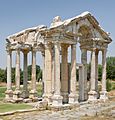Asia Minor facts for kids
Asia Minor, also known as Anatolia, is a large peninsula that makes up most of the Asian part of modern-day Turkey. It also includes the Armenian highland. Today, most people living there speak Turkish. This land is surrounded by three important seas: the Black Sea to the north, the Aegean Sea to the west, and the Mediterranean Sea to the south.
Because Asia Minor sits right between Europe (which was mostly Christian historically) and Asia, it has been a meeting point for many different cultures over thousands of years. You can still find traces of these ancient cultures there today.
Many famous historical groups and empires have lived in or taken over Asia Minor. These include the Hittites, Lydians, Greeks, Persians, Armenians, Romans, Goths, Minoans, Byzantines, and Turks. The Roman Empire even had a special area here called the province of Asia. Later, people started calling the whole continent "Asia," so this peninsula was named "Asia Minor," which means "Little Asia."
One of the most famous ancient cities in Asia Minor is Troy, known from many old stories and myths.
Images for kids
-
Europe during the Last Glacial Maximum, about 20,000 years ago. Anatolia was connected to Europe until around 5600 BCE. Melting ice caused sea levels to rise, creating the Turkish Straits. This connected the Sea of Marmara and the Black Sea to the Mediterranean Sea, separating Anatolia from Europe.
-
Göbeklitepe is an ancient site built as far back as 9600 BC.
-
The Sphinx Gate at Hattusha, an ancient Hittite city.
-
Unique "fairy chimneys" in Cappadocia.
-
The sanctuary of Commagene Kings on Mount Nemrut (1st century BCE).
-
The Mediterranean climate is common in the Turkish Riviera.
-
Climate chart for Ankara (central Anatolia).
-
Climate chart for Antalya (southern Anatolia).
-
Climate chart for Van (eastern Anatolia).
See also
 In Spanish: Anatolia para niños
In Spanish: Anatolia para niños













